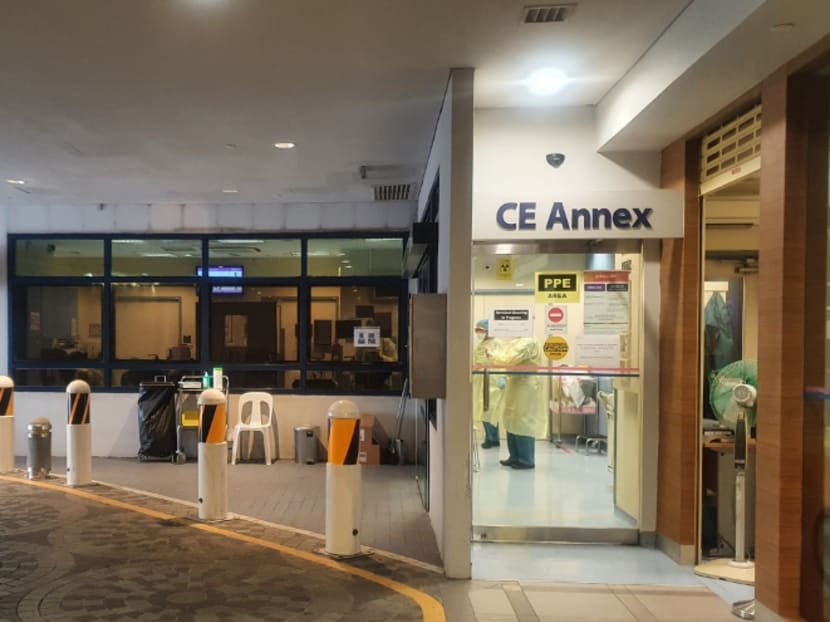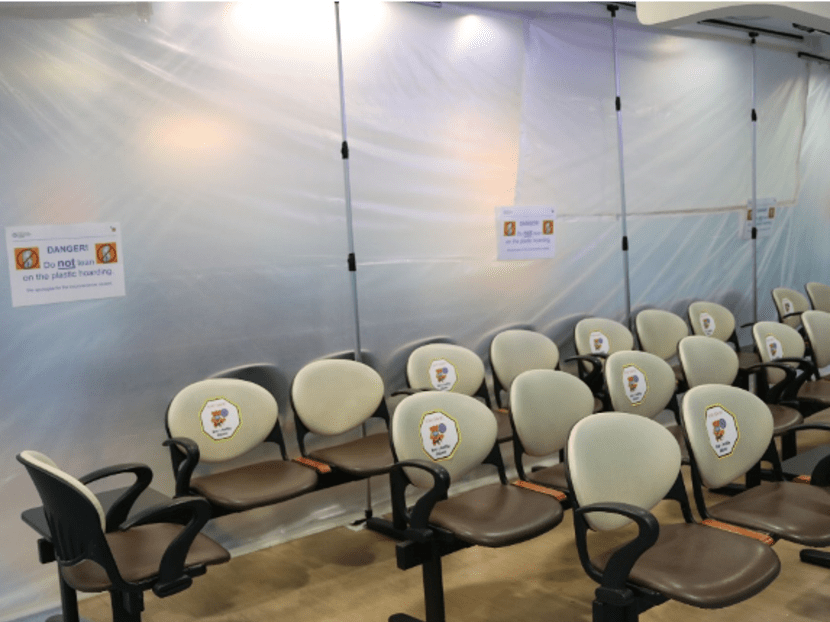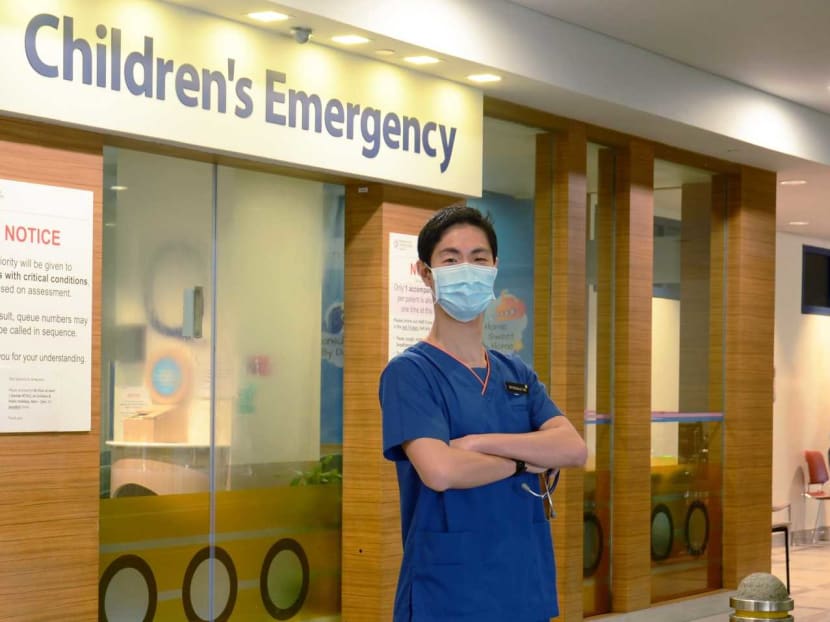Emergency doctors rethink processes as KKH manages fearful parents, crying children during Covid-19 pandemic
SINGAPORE — With more Covid-19 containment measures being lifted, many families with children will be venturing out of their homes this weekend. Some will head to the playgrounds or to the mall while others may dine out.

Walk-in patients deemed to be at high risk based on symptoms and their travel history are seen in a specialised isolation facility at the children's emergency department of KK Women's and Children's Hospital.
SINGAPORE — With more Covid-19 containment measures being lifted, many families with children will be venturing out of their homes this weekend. Some will head to the playgrounds or to the mall while others may dine out.
However, at the children emergency department of KK Women’s and Children’s Hospital (KKH), the battle against the coronavirus is still ongoing for healthcare personnel such as Dr Ronald Tan, who has been pulling extra-long 12-hour shifts at work in the last few months.
“At the KKH children’s emergency department, we are still busy and continuing to see patients. Putting my patients first keeps me going every day,” Dr Tan said.
A consultant with the department of emergency medicine, which sees about 180,000 patients each year, Dr Tan is among the many frontliners who have to be on their toes to contain the spread of Covid-19 while continuing to provide care for patients in need of urgent medical attention.
Having been a doctor for 15 years with three spent working in KKH’s department of emergency medicine, Dr Tan is one of the first points of contact for families with babies and children suspected to have Covid-19. The youngest the hospital had seen was just several months old.
Every day during the peak period in March, the children’s emergency department was screening more than 70 paediatric patients suspected of having Covid-19.
Covid-19 cases are not the only patients the emergency department sees. During this time, it also attends to other medical cases that need urgent care, such as acute illnesses, injuries and poisoning.
While most families who have been tested positive for Covid-19 are “mentally prepared” when they are admitted, Dr Tan said that much of the anxiety is experienced by families who do not have Covid-19 and are afraid of getting it.
“On more than one occasion, I have encountered a parent who did not want their child to be admitted (due to) fear of Covid-19, even though the child needed admission for medical reasons,” he said.
In such cases, taking time to understand their concerns, including speaking to the other parent via phone, often helps clarify any doubts and provides reassurance, Dr Tan said.
DOCUMENTING CHANGES TO WORKFLOW
When Dr Tan and his colleagues first started seeing suspected Covid-19 cases, they were faced with the challenging task of adapting the paediatric emergency department to manage the infectious disease.
Singapore was one of the earliest countries affected by Covid-19 and the rapidly evolving outbreak situation made it challenging to implement logistic and workflow changes while keeping up care for patients, he said.
To mitigate the risks, KKH’s paediatric emergency department adapted several processes, which Dr Tan and the team reported in a review article published in the Emergency Medicine Journal last month.
Despite their busier-than-usual work schedule, Dr Tan said that he and the team felt it was important put together the review to share their perspective and experience in an academic hospital tertiary emergency department.
“This may have useful implications for paediatric emergency departments in other countries preparing for a pandemic,” he explained.
Here are some of the changes they made:
1. Reorganising unit to reduce risks
One of the early measures involved segregating the paediatric emergency department into areas of varying risks: High risk, intermediate risk and low risk.

Workflow and admissions processes were adapted, particularly for patients and caregivers considered to have intermediate or high risk of getting Covid-19.
For example, those deemed to be at high risk based on symptoms and their travel history are seen in a specialised negative-pressure isolation facility. Negative pressure rooms are designed to control airflow in the room to reduce the risk of cross-infection.
For children suspected to have the coronavirus, emergency department personnel wearing full personal protective equipment (PPE) will perform the nasopharyngeal swab test in a dedicated room. This is done by inserting a swab into the nostril. The specimen collected is then hand-delivered to the hospital laboratory in a double bag to prevent transmission to the staff members at the lab.
Dr Tan said: “The older children are quite brave and tolerate it well, while younger children are gently restrained with the help of their caregivers and at times, nurses who are familiar with (managing children), since they do the same for the other routine procedures such as blood-taking.”
While children tend to cry as a form of expression when they are anxious, fearful or distressed — and there have been some crying — Dr Tan said that the paediatric cases have been cooperative and have remained generally well and stable.
2. Reinforcing protection for workers
Dr Tan also said that having the department configured into different risk areas allowed the team to adapt PPE guidelines to a specific area. For example, when working in the low-risk area, only a surgical face mask is needed.
“In the high-risk area, the full set of enhanced PPE includes an N95 face mask, protective eye goggles, gloves and water-resistant gown. And if we are performing aerosol-generating procedures, such as intubation, we add on the use of a powered air-purifying respirator,” Dr Tan said.
The process of putting on and taking off a full set of enhanced PPE, also called donning and doffing, may take around five minutes, he added. During each shift, he may put on and take off such gear several times whenever he enters the high-risk area.

Dr Tan said that the importance of wearing a PPE was emphasised right from the start of his clinical training. He was a medical student during the severe acute respiratory syndrome (Sars) outbreak.
“As we were well-taught in the proper use of PPE, this familiarity stands us in good stead now that we have to use it more extensively and on a regular basis.”

He said that every pandemic carries a new set of lessons and perspective.
Just as Sars and the H1N1 influenza outbreak showed the need for a permanent isolation facility in each emergency department, the team’s Covid-19 experience has highlighted new practical considerations, including the need for structural modifications to the isolation facility, such as anterooms for staff to put on and take off PPE and for staff members to receive regular refresher PPE training.
“There is regular PPE training even in peacetime. However, at the start of the pandemic, it was crucial to ensure all frontline staff are confident in their PPE use. So the refresher training, usually lasting 30 to 60 minutes, came in very useful,” he said.
2. Allowing designated caregivers in isolation wards
One of the concerns of families who have been affected by Covid-19 is the psychological effects of hospitalisation on children during their stay in an isolation room or ward.
To address this, children requiring inpatient treatment are allowed one designated and registered caregiver to stay with them throughout the time they are warded.
Dr Tan said: “In doing our best to keep the family unit together, we have at times had to admit parents as patients. In these uncertain times, it is really important that families feel supported when they are in a crisis.”
However, this may not always be possible, such as in situations whereby the adult is acutely ill (breathless or require intensive care) or has chronic medical conditions requiring adult specialist care.
If an alternate caregiver is available, the child will be admitted with the caregiver who is well and the sick adult will be directed to the National Centre for Infectious Diseases, Dr Tan said.
“Maintaining the family unit as a whole, as far as practical considerations allow, is one way we can help affected families. There is scientific evidence that caring and compassion makes a difference to patients’ lives.”









